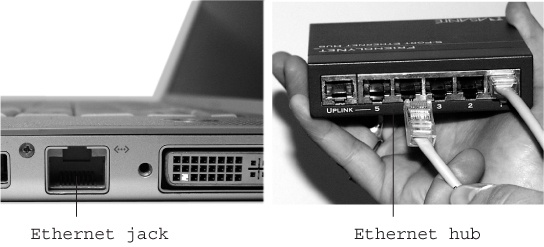Wiring the Network
Most people connect their computers using one of two connection systems: Ethernet or WiFi.
Ethernet Networks
Every Mac (except the MacBook Air) has an Ethernet jack (Figure 14-1). If you connect all the Macs and Ethernet printers in your small office to a central Ethernet hub, switch, or router—a compact, inexpensive box with jacks for five, 10, or even more computers and printers—you’ve got yourself a very fast, very reliable network. (Most people wind up hiding the hub in a closet and running the wiring either along the edges of the room or inside the walls.) You can buy Ethernet cables, plus the hub, at any computer store or, less expensively, from an Internet-based mail-order house; none of this stuff is Mac-specific.
Tip
If you want to connect only two Macs—say, your laptop and your desktop machine—you don’t need an Ethernet hub. Instead, you just need a standard Ethernet cable. Run it directly between the Ethernet jacks of the two computers. (You don’t need a special crossover Ethernet cable, as you did with Macs of old.) Then connect the Macs as described in the box in Gem in the Rough: Networking Without the Network.
Or don’t use Ethernet at all; just use a FireWire cable or a person-to-person WiFi network.

Figure 14-1. Every Mac except the Air has a built-in Ethernet jack (left). It looks like an overweight telephone jack. It connects to an Ethernet router or ...
Get Switching to the Mac: The Missing Manual, Lion Edition now with the O’Reilly learning platform.
O’Reilly members experience books, live events, courses curated by job role, and more from O’Reilly and nearly 200 top publishers.

